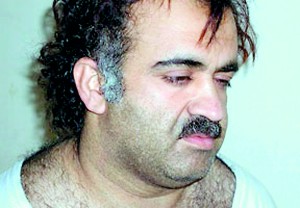Sunday Times 2
9/11 mastermind ‘asked to design’ vacuum cleaner
View(s):Confined to the basement of a CIA secret prison in Romania about a decade ago, Khalid Sheikh Mohammed, the man who masterminded the 9/11 terrorist attacks, asked his jailers whether he could embark on an unusual project.

9/11 mastermind Khalid Sheikh Mohammed, pictured after his 2003 capture, asked the CIA if he could keep himself occupied by designing a vacuum cleaner (Reuters)
Would the spy agency allow Mohammed, who had earned his bachelor’s in mechanical engineering, to design a vacuum cleaner?
The agency officer in charge of the prison called CIA headquarters and a manager approved the request, a former senior CIA official told The Associated Press.
Mohammed had endured the most brutal of the CIA’s harsh interrogation methods and had confessed to a career of atrocities.
But the agency had no long-term plan for him. Someday, he might prove useful. Perhaps, he’d even stand trial one day.
And for that, he’d need to be sane.
‘We didn’t want them to go nuts,’ the former senior CIA official said, one of several who spoke on condition of anonymity because they were not authorized to talk about the now-closed CIA prisons or Mohammed’s interest in vacuums.
So, using schematics from the Internet as his guide, Mohammed began re-engineering one of the most mundane of household appliances.
The unusual activity is reminiscent of Graham Greene’s 1958 spy thriller Our Man in Havana, where a vacuum salesman in Cuba agrees to work for the British international spy service MI6.
He dupes the British into believing his vacuum designs are military installations. It is not known if Mohammed has ever read the novel.
Mohammed graduated from North Carolina AT&T State University with a degree in mechanical engineering in 1986.
It’s not clear whether Mohammed was interested in designing a better vacuum or had ulterior motives.
He might have intended to use the plans to conceal secret information or trick his jailers.
It remains a mystery how far Mohammed got with his designs or whether the plans still exist.
That the CIA may be in possession of the world’s most highly classified vacuum cleaner blueprints is but one peculiar, lasting byproduct of the controversial U.S. detention and interrogation programme.
By the CIA’s own account, the program’s methods were designed to psychologically ‘dislocate’ people
But once interrogations stopped, the agency had to try to undo the psychological damage inflicted on the detainees.
The CIA apparently succeeded in keeping Mohammed sane. He appears to be in good health, according to military records.
Mohammed was subjected to harsh interrogations in Poland. Agency officers and contractors forced him to stay awake for 180 hours, according to a CIA inspector general’s report.
He also underwent 183 instances of waterboarding, or simulated drowning.
After the CIA prison in Poland was closed in September 2003, Mohammed was moved to Bucharest, to a black site code-named ‘Britelite.’ Soon the CIA was trying to find ways to entertain Mohammed as his intelligence value diminished.
The prison had a debriefing room, where Mohammed, who saw himself as something of a professor, held ‘office hours,’ as he told CIA officers.
While chained to the floor, Mohammed would lecture the CIA officers on his path to jihad, his childhood and family. Tea and cookies were served.
Along with the other five detainees at the prison in Bucharest, Mohammed was given assignments about his knowledge of al-Qaeda, or ‘homework,’ as CIA officers called it. He was given Snickers candy bars as rewards for his studiousness.
© Daily Mail, London
Follow @timesonlinelk
comments powered by Disqus

